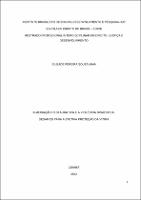Use este identificador para citar ou linkar para este item:
https://repositorio.idp.edu.br//handle/123456789/4197Registro completo de metadados
| Campo DC | Valor | Idioma |
|---|---|---|
| dc.contributor.advisor | Abade, Denise Neves | - |
| dc.contributor.author | Maia, Gileade Pereira Souza | - |
| dc.date.accessioned | 2023-01-19T20:21:06Z | - |
| dc.date.available | 2023-01-19T20:21:06Z | - |
| dc.date.issued | 2022 | - |
| dc.date.submitted | 2023 | - |
| dc.identifier.citation | MAIA, Gileade Pereira Souza. A mediação restaurativa e a violência doméstica: desafios para a efetiva proteção da vítima. 2023. 135 f. Dissertação (Mestrado em Direito).— Instituto Brasileiro de Ensino, Desenvolvimento e Pesquisa, Cuiabá, 2022. | pt_BR |
| dc.identifier.uri | https://repositorio.idp.edu.br//handle/123456789/4197 | - |
| dc.description.abstract | A justiça restaurativa, como visão de justiça que valoriza o posicionamento das partes na resolução do conflito, retira do Estado juiz a tomada de decisões, que é repassada aos envolvidos, priorizando se a reparação dos danos. A presente pesquisa objetivou analisar a efetividade da mediação restaurativa nos conflitos decorrentes de violência doméstica, sopesar as vantagens e os riscos, para averiguar se essa proposta assegura proteção suficiente à vítima. O trabalho iniciou-se com análise dos principais instrumentos normativos internacionais sobre proteção feminina: CEDAW e Convenção de Belém do Pará, expôs a necessidade do controle de convencionalidade e seguiu com a análise da proteção da mulher contra a violência doméstica em âmbito constitucional e infraconstitucional. Contemplou-se as principais decisões do STF e STJ na temática, estudou-se os pressupostos teóricos da mediação restaurativa e a sua aproximação com a violência doméstica no Brasil, retratando a falta de uniformidade teórica e os riscos para a vítima. Na derradeira parte, voltou-se à compreensão das diretrizes para proteção da vítima. Para tanto, falou-se do processo penal eficiente como instrumento de resguardo à mulher vítima de crimes, à luz da Corte IDH. Seguiu-se apontando a necessidade de uma cultura jurídica que incorpore a perspectiva de gênero e possibilite a participação da vítima no processo penal como forma de assegurar seus direitos. Concluiu-se que, embora a mediação restaurativa apresente um potencial inovador por conferir voz aos envolvidos, o modelo, quando aplicado em contexto de violência doméstica, é inconvencional e apresenta perigo de revitimização. O método utilizado foi o indutivo, a partir de pesquisa teórico-reflexiva. | pt_BR |
| dc.description.abstract | Restorative justice, as a vision of justice that values the position of the parties in the resolution of the conflict, removes the decision-making from the State-judge, which is passed on to those involved, prioritizing the repair of the damage. This research aimed to analyze the effectiveness of restorative mediation in conflicts arising from domestic violence, weighing the advantages and risks, to find out whether this proposal ensures sufficient protection to the victim. The work begins with an analysis of the main international normative instruments on the protection of women: CEDAW and the Convention of Belém do Pará, the need for conventionality control was exposed, and the protection of women against domestic violence was analyzed in the constitutional and infra-constitutional scope. The main decisions of the STF and STJ on the subject were considered. The theoretical assumptions of restorative mediation and its approach to domestic violence in Brazil were studied, portraying the lack of theoretical uniformity and the risks for the victim. The third part turned to the understanding of the guidelines for victim protection. To do so, the efficient criminal process was discussed as an instrument to protect women victims of crimes, in the light of the Inter-American Court of Human Rights. The need for a legal culture that incorporates the gender perspective and allows the participation of the victim in the criminal process as a way to ensure her rights was pointed out. It was concluded that, although restorative mediation presents a transformative potential by giving voice to those involved, the model, when applied in the context of domestic violence, is unconventional and presents a danger of revictimization. The method used was inductive, based on reflective-theoretical research. | pt_BR |
| dc.language.iso | por | pt_BR |
| dc.publisher | Instituto Brasileiro de Ensino, Desenvolvimento e Pesquisa | pt_BR |
| dc.rights | Open Access | pt_BR |
| dc.subject | Violência doméstica | pt_BR |
| dc.subject | Proteção à vitima | pt_BR |
| dc.subject | Justiça restaurativa | pt_BR |
| dc.subject | Mediação | pt_BR |
| dc.subject | Resolução de conflito | pt_BR |
| dc.title | A mediação restaurativa e a violência doméstica: desafios para a efetiva proteção da vítima | pt_BR |
| dc.type | Tese de mestrado | pt_BR |
| dc.location.country | BRA | pt_BR |
| Aparece nas coleções: | Mestrado Profissional em Direito, Justiça e Desenvolvimento - São Paulo | |
Arquivos associados a este item:
| Arquivo | Descrição | Tamanho | Formato | |
|---|---|---|---|---|
| REPOSITORIO_GILEADE PEREIRA SOUZA MAIA_MESTRADO DIR_2022.pdf | 947.13 kB | Adobe PDF |  Visualizar/Abrir |
Os itens no repositório estão protegidos por copyright, com todos os direitos reservados, salvo quando é indicado o contrário.
